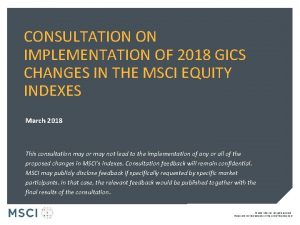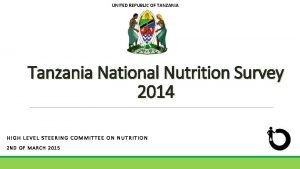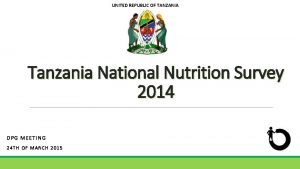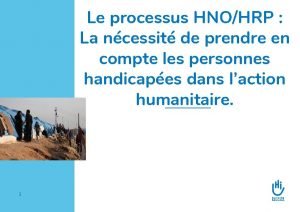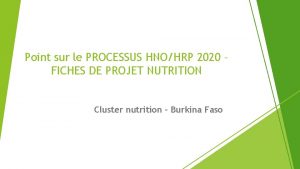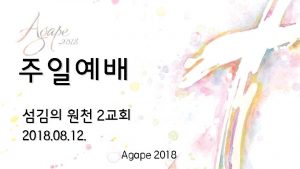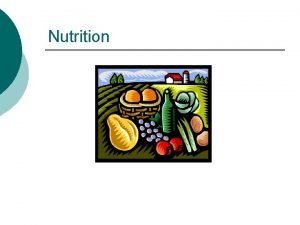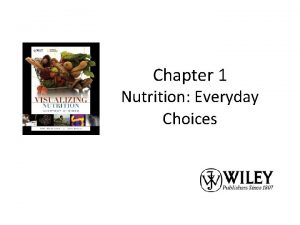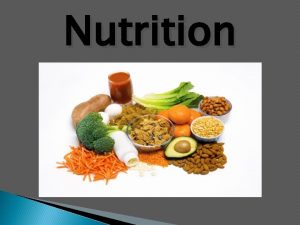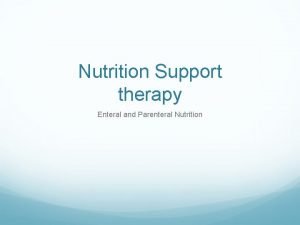HNOHRP Nutrition sector plan 2018 Nutrition sector key










- Slides: 10

HNO/HRP Nutrition sector plan 2018

Nutrition sector key issues to be addressed 2018? Ø Serious nutrition situation with GAM between 10 -14 % rates in northern Borno and parts of central Borno among other aggravating factors. Ø Possible outbreak of water borne and diarrhoea diseases with negative impact on nutrition situation. Ø Inadequate facilities for addressing malnutrition cases with medical complications. Ø MUAC Screening of every child 6 -59 months. Ø Low coverage of MAM cases Ø Slow achievement of set targets in Biu, Damboa, Gwoza, Kalabarge, Kukawa, Mobbar, Ngala and Nganzai Ø ? ? ? ? ?

People In Need INTERNALLY DISPLACED PERSONS RETURNEES HOST COMMUNITY PEOPLE IN INACCESSIBLE AREAS # OF GIRLS (6 - 59 Months) # OF BOYS (6 - 59 Months) 18% of Returnee Population = 228, 265 8% of Returnee Population = 101, 451 18% of Host community population = 3, 738, 770 8% of Host community population = 1, 661, 676 18% of the people living in inaccessible area = 227, 007 8% of the people living in inaccessible area = 100, 892 # OF CHILDREN (6 - 59 Months) 18% of IDP Population = 316, 312 # OF WOMEN 8% of IDP Population = 140, 583 TOTAL 456, 895 329, 716 5, 400, 446 327, 899 Total Pi. N 6, 514, 956 1, 200, 000 1, 000 800, 000 600, 000 # OF CHILDREN (6 - 59 Months) 400, 000 # OF WOMEN 200, 000 0 Adamawa Bauchi Borno Gombe Taraba Yobe States Adamawa Borno Yobe # OF CHILDREN (6 - 59 Months) 645, 356 1, 008, 772 731, 955 # OF WOMEN 286, 825 448, 343 325, 313 Total Pi. N 932, 181 1, 457, 115 1, 057, 268 2, 386, 083 1, 060, 481 3, 446, 56 4 Bauchi Gombe Taraba 1, 069, 780 380, 983 673, 508 475, 458 169, 326 299, 337 1, 545, 238 550, 309 972, 844 2, 124, 271 944, 121 3, 068, 39 2

Proposed interventions 2018 • • • Management of SAM with Medical complication Management of SAM without medical complication OTP Management of Moderate acute Malnutrition PLW & under 5 Infant and young child feeding – IYCF Micro nutrients deficiency control (Vit A, MNP, Fe. Fo and deworming Blanket Feeding supplementation children Under 5 and PLW. Monitoring and assessment ( SMART survey, KAP, NCA and Coverage assessments) Capacity building and training CBT/ Multi purpose Cash transfers on Nutrition

Targeting criteria Methodology People in Need SAM without medical complication (6 -59 m) 18% of the population * SAM (WHZ)% * 9 SAM with Medical complication (6 -59 m) 18% of the population * SAM (WHZ)% * 9 MAM < 5 18% of the population * MAM (WHZ)% * 2. 6 MAM PLW 8% of the population * MUAC <221 mm% * 1. 5 BSFP <5 18% of the population BSFP PLW 8% of the population VIT A <5 18% of the population Pregnant _ Iron 5% of the population*0. 375 or 0. 625 * PLW of Pi. N Population category * 0. 375 Deworming (12 -59 m) (18% of the population)*90% MNP (6 -23 m) 6% of total population*. 3335 or 0. 625 * PLW of Pi. N Population category * 0. 3335 IYCF -PLW 8% of the population

Proposed Intervention Targets Indicators # OF CHILDREN Burden SAM OTP Burden SAM SC Burden # OF CHILDREN MAM # OF CHILDREN BSFP # OF CHILDREN VIT A # OF CHILDREN MNP # OF CHILDREN Deworming Iron Folate PLW /MNT IYCF PLW MAM PLW BSFP PLW Adamawa Pi. N Target Borno Pi. N Yobe Target Pi. N Total Target Pi. N 34, 23, 8 207, 5 138, 4 439, 371 022 15 21 145, 265 197, 828 80 30, 21, 4 186, 7 124, 6 395, 434 620 34 69 130, 738 178, 045 32 3, 2, 3 20, 7 13, 8 43, 937 402 82 52 14, 526 19, 783 48 85, 42, 7 238, 7 89, 0 502, 299 512 65 58 119, 392 178, 029 23 645, 258, 1 1, 008, 7 292, 7 2, 386, 083 356 44 72 403, 514 731, 955 83 645, 516, 2 1, 008, 7 585, 5 2, 386, 083 356 84 72 807, 017 731, 955 62 161, 112, 9 252, 3 128, 1 596, 823 418 92 21 176, 627 183, 084 61 580, 464, 6 907, 8 527, 0 2, 147, 475 821 54 94 726, 321 658, 759 07 67, 53, 8 105, 5 61, 0 249, 120 291 33 33 84, 426 76, 296 37 286, 200, 7 448, 3 227, 7 1, 060, 481 825 78 43 313, 843 325, 313 22 30, 15, 0 108, 0 45, 9 230, 137 162 87 29 54, 021 91, 946 78 286, 114, 7 448, 3 130, 1 1, 060, 481 825 31 43 179, 336 325, 313 24 Pi. N Children <5 Beneficiaries PLW Beneficiaries Target 307, 560 276, 804 30, 756 251, 180 954, 441 1, 908, 863 417, 780 1, 717, 982 199, 296 742, 343 115, 086 424, 191 Target 2, 386, 08 1, 908, 86 3 3 1, 060, 48 742, 1 3 3, 446, 564 2, 651, 206

Proposed Sector objectives 2017 2018 • • Improve equitable access to quality lifesaving services for management of acute malnutrition for children (boys and girls 6 -59 months) and pregnant and breastfeeding women through systematic identification, referral and treatment of acutely malnourished cases. Promote access to services preventing under-nutrition for the vulnerable groups (children under five and pregnant and caregivers of children less than 2 years of age) focusing on infant and young child feeding in emergencies, micronutrient supplementation, and blanket supplementary feeding. • Strengthen in scale the availability of quality services managing acute malnutrition for children (boys and girls 6 -59 months) and pregnant and breastfeeding women through increasing access to treatment. • Increase capacity to identify malnourished children and refer them for treatment as well promote services preventing undernutrition while supplementing for micro- nutrients deficiencies. • Enhance routine monitoring of the emergency nutrition situation through regular assessment analysis of data, while strengthening coordination within the nutrition partners and other sectors.

Plenary discussion • Strengthen in scale the availability of quality services managing acute malnutrition for children (boys and girls 6 -59 months) and pregnant and breastfeeding women through increasing access to treatment. • Increase capacity to identify malnourished children and refer them for treatment as well promote services preventing undernutrition while supplementing for micro- nutrients deficiencies. • Enhance routine monitoring of the emergency nutrition situation through regular assessment analysis of data, while strengthening coordination within the nutrition partners and other sectors. What suggestions do we have to the proposed Sector objectives? ? What indicators we can use to monitor the proposed objectives.

Nutrition sector response strategies • Provision of quality care for treatment and management of acute malnutrition • Strengthening community capacity and linkages to enhance early identification of malnutrition and referral to facilities and participate in the promotion and support of optimal infant and young child feeding practices • Prevention and protection of vulnerable groups, against the deterioration of nutrition status and to mainstream gender and protection in programme delivery • Strengthen nutrition surveillance systems to monitor the nutrition situation • Strengthening nutrition sector coordination and partners engagement with and across other sectors such as Food Security, Health, WASH and Education when possible

Critical Discussions & Way forward • 3 rd Objective on assessment and coordination – Do we include this as nutrition sector objective • MAM treatment in 2018, as the Guideline revision is initiated and commitment from WFP to undertake it : - Sector partners should also include this in their OPS • Planning for supplies? – one project sheet managed by UNICEF on behalf of the sector with all sector supplies requirement • Targeting – To be based on geographical coverage and take into consideration scale-up plans of the different partners.

